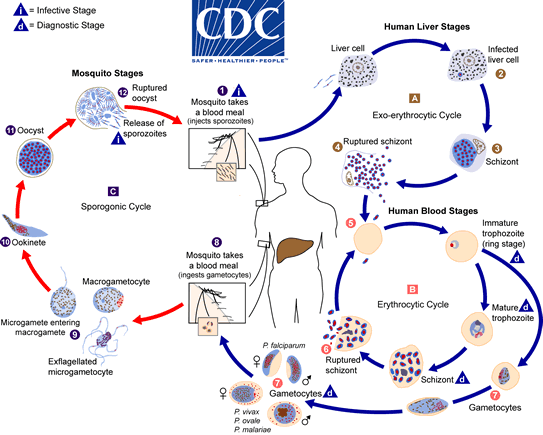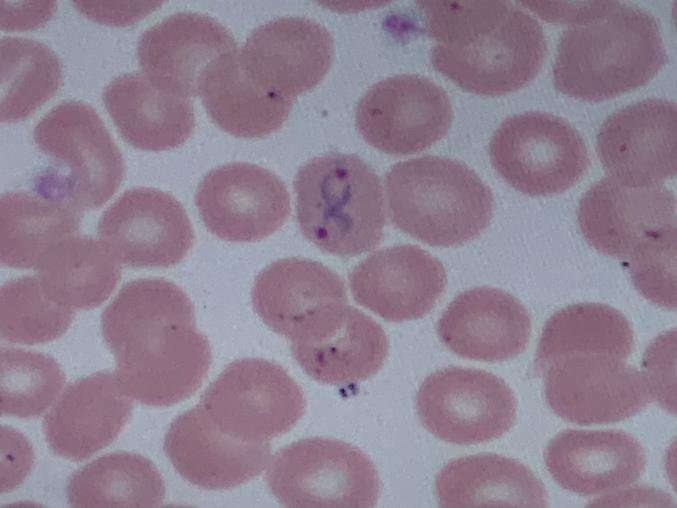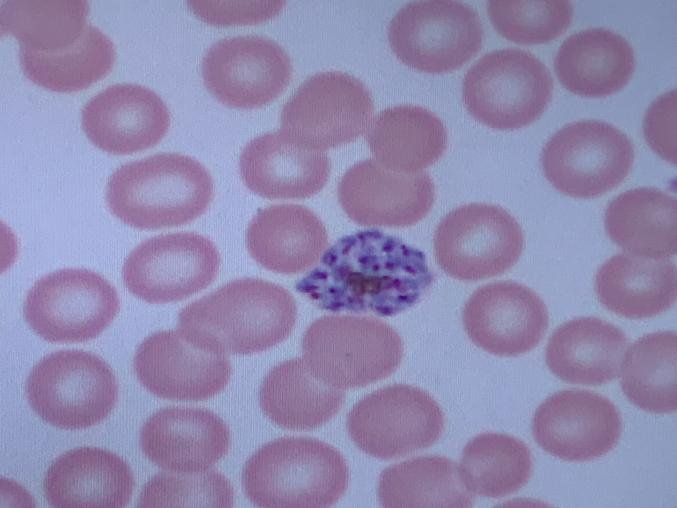A Night at the Lab: Thin Blood Smears
Here is something fun from work this week. We don't often get positive malaria smears, but they do happen. The key to reading malarial smears is knowing what is not in normal blood.
I have attached a nice CDC infographic about the malarial life cycle.

Background
Pacific Islander male in his early 20's. No travel history in the last 30 days. Before anyone goes off about malaria at where he is from, the answer is no. There's no transmission of malaria in his home country. Patient has a history of malaria.
Thin Smears Under the Scope

One of the tell-tale signs of malarial infection is seeing the trophozoites in ring stage. In this case, the "rings" look more like baskets, so there's a chance it's not Plasmodium falciparum.

This is most likely the best-looking schizont I have ever seen in a patient sample. That's not saying much because a smear is a lower tech approach compared to all the methods available.

At first glance, one could mistaken this for an enlarged lymphocyte. But, that is not a normal blood cell. It is likely to be a gametocyte from the parasite.
Conclusion
The patient definitely has malaria. The percent parasitemia was about 1%.
The lab does not speciate the parasites at the general level. That is up to the pathologists and infectious disease specialists.
If I were to guess, I would say P. malariae. This is due to the well-defined trophozoite rings and normal-sized blood cells. The gametocytes were large unlike other species.
As to why does this young man have malaria? Well, that's some digging the infectious disease doctor would have to do.
@tipu curate
Upvoted 👌 (Mana: 7/18)
Haha it's been a long time since anyone tried to Tipu me.
I found this really interesting.. made me think. You said patient has a history of malaria. Might be a case of relapsing malaria. If that's the case then the parasite might be p.vivax
Ooo and that would make sense. I bet the RDW, MCV, etc. would give a clue if I pulled the results from hematology.
Good thing I'm not the pathologist. lol
Haha, so confusing. I remember there are multiple rings in falciparum but the gametocyte of falciparum is always crescent-shaped. damn my brain hurts trying to remember old lectures :D. Please update us when you get the results.
I'll try to follow up on this case.
So, the pathologists resulted the stain as P. vivax. They said other species can have multiple rings.
They are waiting for the PCR results and they also suspect it could be P. knowlesi.
The only travel history that correlates is the patient been in Soloman Islands multiple times in the past.
Stay tuned.
Very interesting. Parasitemia 1%, case of relapsing malaria suggested p.vivax.. very hard to differentiate just by looking at these pics
Let's see what PCR results will be
The PCR results are back.
It is indeed P. vivax. Thank goodness only reference labs do the speciation.
finally, the mystery has been solved :P .. btw, thanks for keeping us updated.
Wow, i'm easy, but wow.
We've had new mosquitos in my SoCal area. "Zebra" mosquito or something. Not fun.
I don't see the "baskets."
Oh.......... maybe you're referring to the purple square thing in the last image. That doesn't even look normal to me. Run awa... err stay safe. :)
(Did you use your camera phone to capture those images?)
I was talking about the rings.
And no, those images were from the computer screen attached to the microscope. Phones are generally discouraged in laboratory settings.
I see the baskets now. Bottom to bottom like a mirror image of the letter "C" on its side.
Something like that.
Very interesting! This is really cool stuff. Oh, this post made me think of a conversation I had last weekend. I was talking to a young lady who works in the crime lab for the police department. She mainly tests substances that the police send in to see if they are drugs or not. She had some really interesting stories!
Toxicology is another interesting lab specialty as well.
Congratulations @enforcer48! You have completed the following achievement on the Hive blockchain and have been rewarded with new badge(s) :
You can view your badges on your board And compare to others on the Ranking
If you no longer want to receive notifications, reply to this comment with the word
STOPSupport the HiveBuzz project. Vote for our proposal!
Thanks for your contribution to the STEMsocial community. Feel free to join us on discord to get to know the rest of us!
Please consider supporting our funding proposal, approving our witness (@stem.witness) or delegating to the @stemsocial account (for some ROI).
Please consider using the STEMsocial app app and including @stemsocial as a beneficiary to get a stronger support.
Is this H&E staining?
Nah, just Wright.
Malaria in Utah? Wow! I didn't even know this was possible. I would have expected that more likely in a state like Florida...
The closest I was with Malaria was during my two visits at the Kruger Park in South Africa...
Utah itself doesn't have malaria.
Most of the cases we get here are due to traveling (i.e. younger population and overseas missionaries), immigrants from a susceptible area, and possible relapses like this particular patient.
Generally speaking, if you are taking your prophylaxis correctly and on time, the chance of you acquiring malaria is low.
Exactly. It tastes so bad... :)
interesting. what does percent parasitemia was about 1% means?
Meaning about 1% of the patient’s red blood cells are infected by the parasite.
aah I see
That % only include the intracellular parasites.
We don't count gametocytes and schizonts.